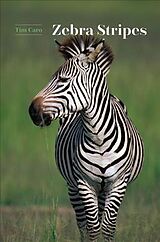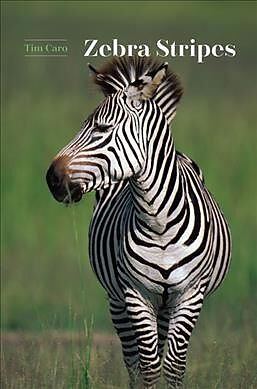Zebra Stripes
Einband:
Fester Einband
EAN:
9780226411019
Untertitel:
Englisch
Genre:
Biologie
Autor:
Tim Caro
Herausgeber:
The University of Chicago Press
Anzahl Seiten:
320
Erscheinungsdatum:
05.12.2016
ISBN:
978-0-226-41101-9
Klappentext From eminent biologists like Alfred Russel Wallace and Charles Darwin to famous authors such as Rudyard Kipling in his Just So Stories! many people have asked! "Why do zebras have stripes?" There are many explanations! but until now hardly any have been seriously addressed or even tested. In Zebra Stripes! Tim Caro takes readers through a decade of painstaking fieldwork examining the significance of black-and-white striping and! after systematically dismissing every hypothesis for these markings with new data! he arrives at a surprising conclusion: zebra's markings are nature's defense against biting fly annoyance. Popular explanations for stripes range from camouflage to confusion of predators! social facilitation! and even temperature regulation. It is a challenge to test these proposals on large animals living in the wild! but using a combination of careful observations! simple field experiments! comparative information! and logic! Caro is able to weigh up! scientifically! the pros and cons of each idea. Eventually--driven by experiments showing that biting flies avoid landing on striped surfaces! observations that striping is most intense where biting flies are abundant! and by his knowledge of zebras' susceptibility to biting flies and vulnerability to the diseases that flies carry--Caro concludes that black-and-white stripes are an adaptation to thwart biting fly attack. Not just a tale of one scientist's quest to solve a classic mystery of biology! Zebra Stripes is also a testament to the tremendous value of longitudinal research in behavioral ecology! demonstrating how observation! experiment! and comparative research can reshape our understanding of the natural world. Zusammenfassung Countless children s books pose the question! Why do zebras have their stripes? Many a researcherfrom Darwin and Wallace to T. M. Carohas attempted to answer the same. Zebra stripes are visually arresting! and scientifically perplexing. Their high contrast is unlike anything else found in mammals. Some have hypothesized that the coloration is an anti-predator defense! to confuse lions that approach a herd of stripes. The stripes aren t likely camouflage or crypsis! which has also been proposed! as zebras are easy to see in the wild! and their movements and tail swishing are obvious at even a distance. The animals themselves seem to use other cues for recognition! so the stripes don t seem to be individual identifiers for the zebras themselves. T.M. Caro! who has been studying zebras for several decades! thinks the stripes may be nature s defense against insect bites There is greater striping in areas of the body in regions of greater fly population. Zebra hair is shorter than a fly s mouthpart! making them more susceptible to the irritation caused by the fly s bite. Researchers have since been studying the flies too! to figure out how the stripes don t serve as fly runways. This is a work that explores the various hypotheses for the existence of zebra stripes! and also shares experiences of field based research. The book allows readers to see how ideas are shaped by research! and influenced by observation and experiment alike. Over 18 serious hypotheses are considered! and herds more of outlandish ideas are touched upon as well. The answer is not so black and white! but the question involves terrific science. " ...
Zusammenfassung
Countless children s books pose the question, Why do zebras have their stripes? Many a researcherfrom Darwin and Wallace to T. M. Carohas attempted to answer the same. Zebra stripes are visually arresting, and scientifically perplexing. Their high contrast is unlike anything else found in mammals. Some have hypothesized that the coloration is an anti-predator defense, to confuse lions that approach a herd of stripes. The stripes aren t likely camouflage or crypsis, which has also been proposed, as zebras are easy to see in the wild, and their movements and tail swishing are obvious at even a distance. The animals themselves seem to use other cues for recognition, so the stripes don t seem to be individual identifiers for the zebras themselves. T.M. Caro, who has been studying zebras for several decades, thinks the stripes may be nature s defense against insect bites There is greater striping in areas of the body in regions of greater fly population. Zebra hair is shorter than a fly s mouthpart, making them more susceptible to the irritation caused by the fly s bite. Researchers have since been studying the flies too, to figure out how the stripes don t serve as fly runways. This is a work that explores the various hypotheses for the existence of zebra stripes, and also shares experiences of field based research. The book allows readers to see how ideas are shaped by research, and influenced by observation and experiment alike. Over 18 serious hypotheses are considered, and herds more of outlandish ideas are touched upon as well. The answer is not so black and white, but the question involves terrific science. "

Leider konnten wir für diesen Artikel keine Preise ermitteln ...
billigbuch.ch sucht jetzt für Sie die besten Angebote ...
Die aktuellen Verkaufspreise von 6 Onlineshops werden in Realtime abgefragt.
Sie können das gewünschte Produkt anschliessend direkt beim Anbieter Ihrer Wahl bestellen.
Loading...
Die aktuellen Verkaufspreise von 6 Onlineshops werden in Realtime abgefragt.
Sie können das gewünschte Produkt anschliessend direkt beim Anbieter Ihrer Wahl bestellen.
| # | Onlineshop | Preis CHF | Versand CHF | Total CHF | ||
|---|---|---|---|---|---|---|
| 1 | Seller | 0.00 | 0.00 | 0.00 |
